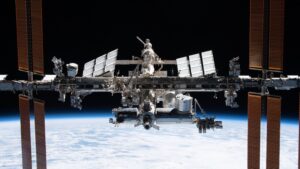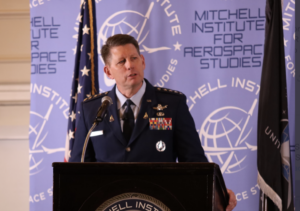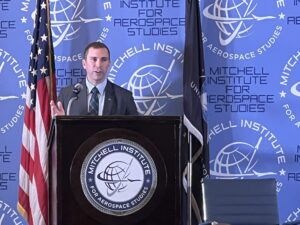International Space Station maneuvers to avoid debris
Wednesday, 26 October 2022 11:48 The International Space Station adjusted its orbit Monday night to avoid space debris, NASA said.
"This evening, the International Space Station's Progress 81 thrusters fired for 5 minutes, 5 seconds in a Pre-Determined Debris Avoidance Maneuver to provide the complex an extra measure of distance away from the predicted track of a fragment of Russian Cosmos 1408 debris," according to a
The International Space Station adjusted its orbit Monday night to avoid space debris, NASA said.
"This evening, the International Space Station's Progress 81 thrusters fired for 5 minutes, 5 seconds in a Pre-Determined Debris Avoidance Maneuver to provide the complex an extra measure of distance away from the predicted track of a fragment of Russian Cosmos 1408 debris," according to a Mengtian space lab to undergo final tests before launch
Wednesday, 26 October 2022 11:48 China's Mengtian space lab module and its carrier - a Long March 5B rocket - were moved to a service tower on Tuesday morning to undergo final tests before their planned flight in the coming days, according to the China Manned Space Agency.
The agency said in a brief news release that prelaunch preparation work is underway at the Wenchang Space Launch Center in the southernmost island prov
China's Mengtian space lab module and its carrier - a Long March 5B rocket - were moved to a service tower on Tuesday morning to undergo final tests before their planned flight in the coming days, according to the China Manned Space Agency.
The agency said in a brief news release that prelaunch preparation work is underway at the Wenchang Space Launch Center in the southernmost island prov China to invest in major space programs
Wednesday, 26 October 2022 11:48 China Aerospace Science and Technology Corp, the country's leading space contractor, will continue to invest in major space programs such as the manned lunar missions and the development of a super-heavy carrier rocket, said the company's chairman.
Chairman Wu Yansheng told reporters on Saturday that his company has set three goals for its future development - upgrading the existing rocket
China Aerospace Science and Technology Corp, the country's leading space contractor, will continue to invest in major space programs such as the manned lunar missions and the development of a super-heavy carrier rocket, said the company's chairman.
Chairman Wu Yansheng told reporters on Saturday that his company has set three goals for its future development - upgrading the existing rocket NASA announces Unidentified Aerial Phenomena study team members
Wednesday, 26 October 2022 11:48 NASA has selected 16 individuals to participate in its independent study team on unidentified aerial phenomena (UAP). Observations of events in the sky that cannot be identified as aircraft or as known natural phenomena are categorized as UAPs.
The independent study will begin on Monday, Oct. 24. Over the course of nine months, the independent study team will lay the groundwork for future
NASA has selected 16 individuals to participate in its independent study team on unidentified aerial phenomena (UAP). Observations of events in the sky that cannot be identified as aircraft or as known natural phenomena are categorized as UAPs.
The independent study will begin on Monday, Oct. 24. Over the course of nine months, the independent study team will lay the groundwork for future TanSat's first attempt to detect human-caused CO2 is successful
Wednesday, 26 October 2022 11:48 An international research team has analyzed measurements from the TanSat mission and the Copernicus Sentinel-5 Precursor mission to identify carbon dioxide from human activities. This is the first attempt to use TanSat measurements to detect anthropogenic, or human-caused, carbon dioxide emission signatures. Quantifying anthropogenic carbon dioxide emissions is one of the most important requirem
An international research team has analyzed measurements from the TanSat mission and the Copernicus Sentinel-5 Precursor mission to identify carbon dioxide from human activities. This is the first attempt to use TanSat measurements to detect anthropogenic, or human-caused, carbon dioxide emission signatures. Quantifying anthropogenic carbon dioxide emissions is one of the most important requirem ISS partners weigh options for using commercial space stations
Wednesday, 26 October 2022 10:34
Partner agencies on the International Space Station program say they are in discussions about how they will use, and pay for, commercial space stations that will replace it.
The post ISS partners weigh options for using commercial space stations appeared first on SpaceNews.
ESA plans for low-orbiting navigation satellites
Wednesday, 26 October 2022 10:21
Satellite navigation is headed closer to users. ESA’s Navigation Directorate is planning an in-orbit demonstration with new navigation satellites that will orbit just a few hundred kilometres up in space, supplementing Europe’s 23 222-km-distant Galileo satellites. Operating added-value signals, these novel so-called ‘LEO-PNT’ satellites will investigate a new multi-layer satnav system-of-systems approach to deliver seamless Positioning, Navigation and Timing services that are much more accurate, robust and available everywhere.
Craters and cracks on Mars
Wednesday, 26 October 2022 08:00
This complex region of craters and fractures in the Terra Sirenum region highlights the varied history of Mars. The image was taken by ESA’s Mars Express on 5 April 2022.
Proba-2 sees two partial eclipses
Wednesday, 26 October 2022 07:00 Video:
00:00:23
Video:
00:00:23
ESA’s Proba-2 captured two partial solar eclipses on 25 October 2022.
A solar eclipse is caused by the movement of the Moon around Earth. Despite their much different sizes, due to their separation, the Moon appears to be about the same size as the significantly larger Sun in the sky. Occasionally, the Moon passes in front of the Sun, blocking its light, so that part of the Earth’s surface is in the Moon’s shadow. The line-up is not always perfect, and so not every eclipse is a total solar eclipse.
On 25 October only part of the Sun’s light was
Space Force to seek budget boost beyond 2023, China’s capabilities are ‘close to ours’
Tuesday, 25 October 2022 20:47
Gen. David "DT" Thompson, U.S. vice chief of space operations, said the Space Force is likely to see continued funding increases to counter China’s rapid advances in its space program.
The post Space Force to seek budget boost beyond 2023, China’s capabilities are ‘close to ours’ appeared first on SpaceNews.
Partial solar eclipse takes a bite out of the sun
Tuesday, 25 October 2022 20:13
Newly acquired NanoAvionics plots major smallsat expansion
Tuesday, 25 October 2022 19:33
NanoAvionics expects to be able to churn out several hundred satellites annually in two years following a multimillion-dollar investment plan from its new Norwegian owners.
The post Newly acquired NanoAvionics plots major smallsat expansion appeared first on SpaceNews.
ISS habitat is safe for its residents, according to 5-year microbial study
Tuesday, 25 October 2022 18:14
A 5-year microbial study of the International Space Station (ISS) and its astronauts by Lawrence Livermore National Laboratory (LLNL) and NASA researchers has found that the ISS habitat is safe for its residents.
The research effort represents the first comprehensive characterization of the space station's environmental profile (or microbiome) and is the first to compare the ISS microbiome to an astronaut's microbiome using metagenomic DNA sequencing techniques.
Researchers create lunar regolith bricks that could be used to construct Artemis base camp
Tuesday, 25 October 2022 17:52
As part of NASA's Artemis program to establish a long-term presence on the moon, it aims to build an Artemis base camp that includes a modern lunar cabin, rover and mobile home. This fixed habitat could potentially be constructed with bricks made of lunar regolith and saltwater, thanks to a recent discovery from a team of UCF researchers.
Associate Professor Ranajay Ghosh of UCF's Department of Mechanical and Aerospace Engineering and his research group found that 3D-printed bricks of lunar regolith can withstand the extreme environments of space and are a good candidate for cosmic construction projects. Lunar regolith is the loose dust, rocks and materials that cover the moon's surface.
The results of their experiments are detailed in a recent issue of Ceramics International.
To create the bricks, Ghosh's team in the Complex Structures and Mechanics of Solids (COSMOS) Lab used a combination of 3D printing and binder jet technology (BJT), an additive manufacturing method that forces out a liquid binding agent onto a bed of powder.
Starlink’s survivability in war a good sign for DoD’s future constellation
Tuesday, 25 October 2022 17:47
SDA Director Derek Tournear said Starlink's performance so far speaks to the power of a proliferated constellation to deter attacks and provide resilience
The post Starlink’s survivability in war a good sign for DoD’s future constellation appeared first on SpaceNews.

